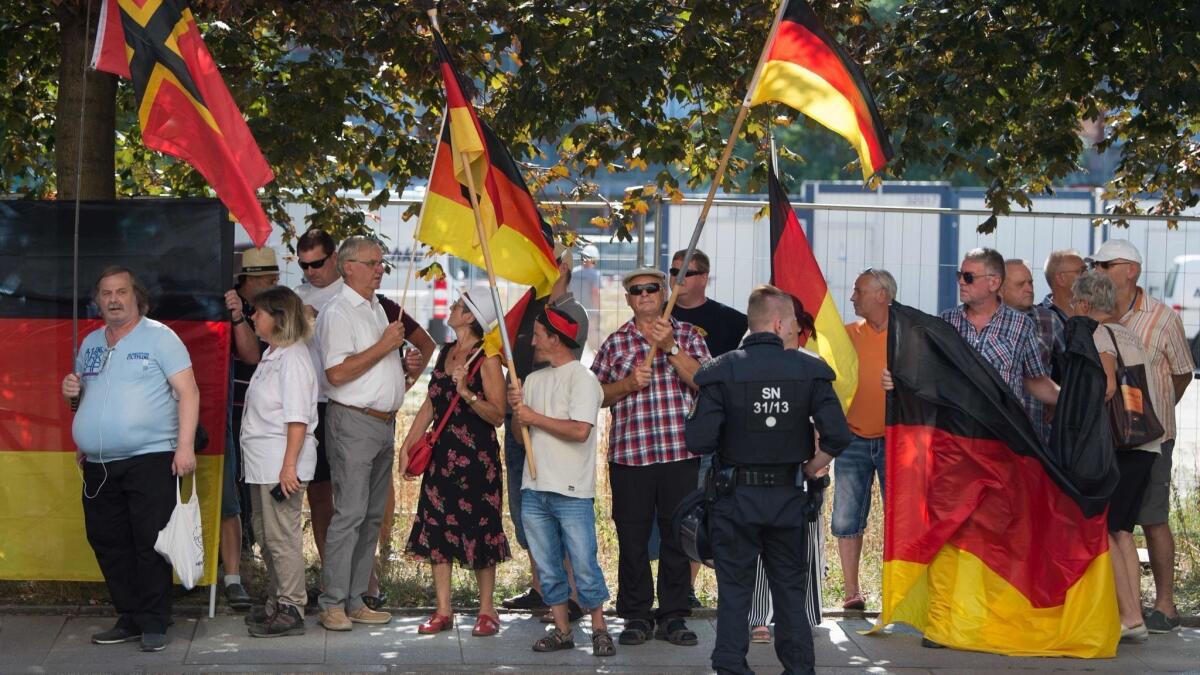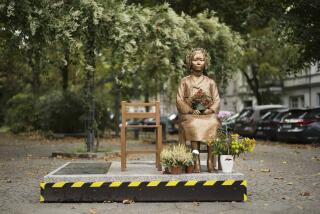Germany still has an East-West divide — but now it’s about attitudes toward refugees

- Share via
Reporting from Dresden, Germany — Ingolf Koecher and his wife, Bettina, have marched in 120 anti-Islam rallies in the former East German city of Dresden during the last four years.
The retired factory workers say they fear being mugged by one of the million foreign asylum-seekers from the Middle East who have arrived in Germany in recent years – and they bristle at the notion that they are in league with far-right or neo-Nazi fringe groups behind recent outbursts of violence against foreigners here.
At the same time, the Koechers readily acknowledge that frustrations with refugees are particularly heavy in eastern Germany, once run by a regime that erected barriers to prevent its own citizens from fleeing oppressive leadership.
“There’s a lot of frustration across Germany about all the immigrants coming in and that anger is especially strong here in the east,” said Ingolf, 73, former union leader at an office supplies and pen factory. “We’re allergic to mass immigration here in the east.”
“It’s turning into an explosive situation. It’s getting dangerous.”
The couple has been to most of the 155 PEGIDA (Patriotic Europeans Against the Islamisation of the West) marches in Dresden since 2014 – rallies filled with anti-Islam and anti-foreigner venting. The venomous sessions have attracted 1,500 to 25,000 people almost every Monday evening.
The Koechers, who describe themselves as ordinary, middle-of-the-road Germans, are among at least a quarter of citizens in the state of Saxony who share the view that Chancellor Angela Merkel sold out her country when she threw open its borders in 2015 to allow in stranded refugees from Syria, Iraq and other troubled lands.
(President Trump also blasted Merkel at the time, tweeting after she was named Time magazine’s person of the year that she was “ruining Germany”).
While many across Germany at first welcomed the immigrants, some of whom had been trapped on their way north in Hungary and in the Balkans, that sentiment has cooled, particularly in Saxony, where Dresden is the capital.

Theories abound over why the five states in the region are prone to far-right fervor compared with the 11 states that comprised West Germany, where the horrors of the Nazi past have been thoroughly discussed and dissected the last seven decades.
One possibility is that few Saxons, especially in the Elbe River Valley where Dresden lies, were able to watch West German television or listen to radio broadcasts from behind the Berlin Wall during the Cold War, limiting their exposure to a multicultural world that flowered next door. Because of that, Dresden and the region around it was called Tal der Ahnungslose (Valley of the Clueless) in East Germany.
As well, easterners were taught that contract laborers from fellow communist countries such as Vietnam and Cuba remained as guests for a limited period. Such foreigners consequently were far less integrated than those from Turkey and Italy who worked and settled in West Germany.
Residents here also have retained a sense of victimhood and resentment. Dresden, largely destroyed by American and British warplanes near the end of World War II, has long served as the venue for Germany’s biggest neo-Nazi marches – which take place each year on Feb. 13 to mark the anniversary of the bombings that killed at least 35,000 people.
Since the fall of the Berlin Wall, leaders in Saxony have perhaps compounded the problem by insisting their state along the Czech and Polish borders was immune to neo-Nazism even though the far-right already boasted a persistent presence.
Many here now view it as their patriotic duty to resist Merkel, who was raised in East Germany herself, and open-door policies that have been placed on the European Union, because members such as Hungary, Poland and the Czech Republic firmly reject welcoming refugees.
The far-right Alternative for Germany (AfD) party won 13% of the national vote in the 2017 election that gave Merkel her fourth term but the party scored more than twice that percentage in Saxony. After refugee centers were attacked in several Saxon cities in 2015, then-President Joachim Gauck called Saxony part of Dunkeldeutschland (dark Germany).
Three weeks ago in the Saxon city of Chemnitz, mobs rampaged and hunted down foreigners following the stabbing death of a 35-year-old German man. The turmoil was sparked when a pair of refugees from Syria and Iraq were arrested on suspicion they committed the crime.
Chemnitz marked the first time in which a radical far-right group joined arms with the far larger number of everyday Saxons who had long eschewed violence. Suddenly, it seemed socially acceptable for the leaders of the far right and the local AfD to mourn together.
“Merkel’s uncontrolled immigration is the root of the problem,” said Bettina Koecher, 70, reflecting a widely held view in a state where foreigners comprise less than 5% of a population of 4 million. “We don’t want to be afraid to go out on our streets.”
A German government report last year found many easterners tended to see themselves as looked down upon by the west at the same time they believe migrants have achieved a privileged position – provided shelter and monthly welfare support payments despite contributing next to nothing to the economy.
The government also reported that roughly half of 23,500 right-wing hate crimes across the nation in 2016 occurred in the east, even though only about a fifth of the nation’s population lives there.
“A lot of easterners feel run over by the migration policies that they feel were forced upon them by the federal government that is dominated by westerners,” said Werner Patzelt, a professor at Dresden’s Institute for Political Science.
While Dresden is one of the largest cities in eastern Germany and a thriving university town with relatively low unemployment levels, it is striking how few foreigners or migrants with dark skin are visible on its streets compared with Berlin and major cities in the west – where up to a third or more of the population is foreign born.
“The mood has definitely taken a turn for the worse,” said a 19-year-old woman born in Morocco who moved to Dresden 12 years ago. She did not want to give her real surname, emphasizing she has become the target of abuse in recent weeks.
“People are now shouting, ‘Foreigners out,’ at me and my four brothers and it’s scary at times,” she said, while waiting for a street car in the city center. “They’re afraid. And I’m worried about the safety of my mother because she wears a headscarf. Everyone assumes all foreigners are criminals now. But that’s not the way it is.”
Kirschbaum is a special correspondent.
More to Read
Sign up for Essential California
The most important California stories and recommendations in your inbox every morning.
You may occasionally receive promotional content from the Los Angeles Times.










